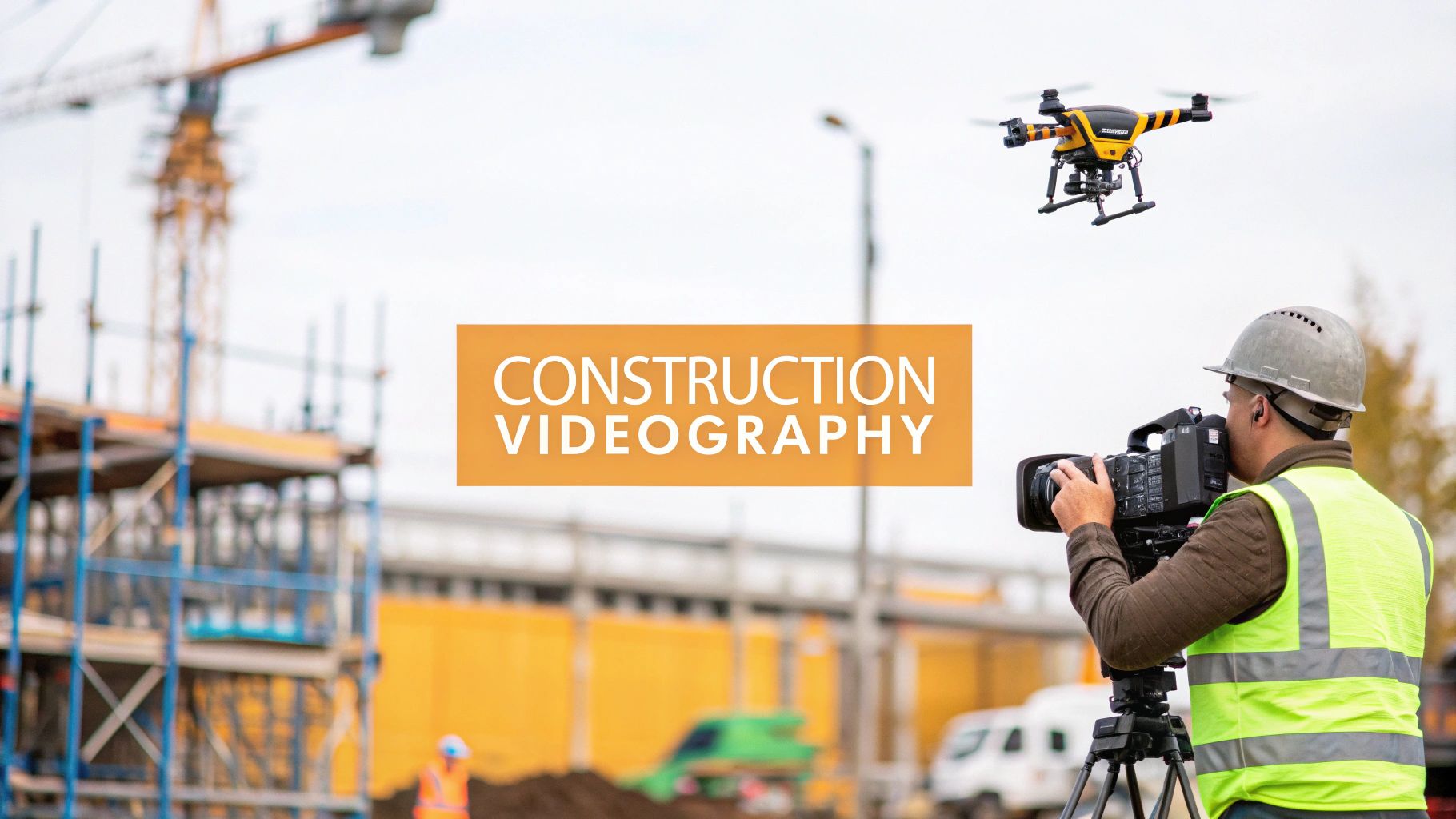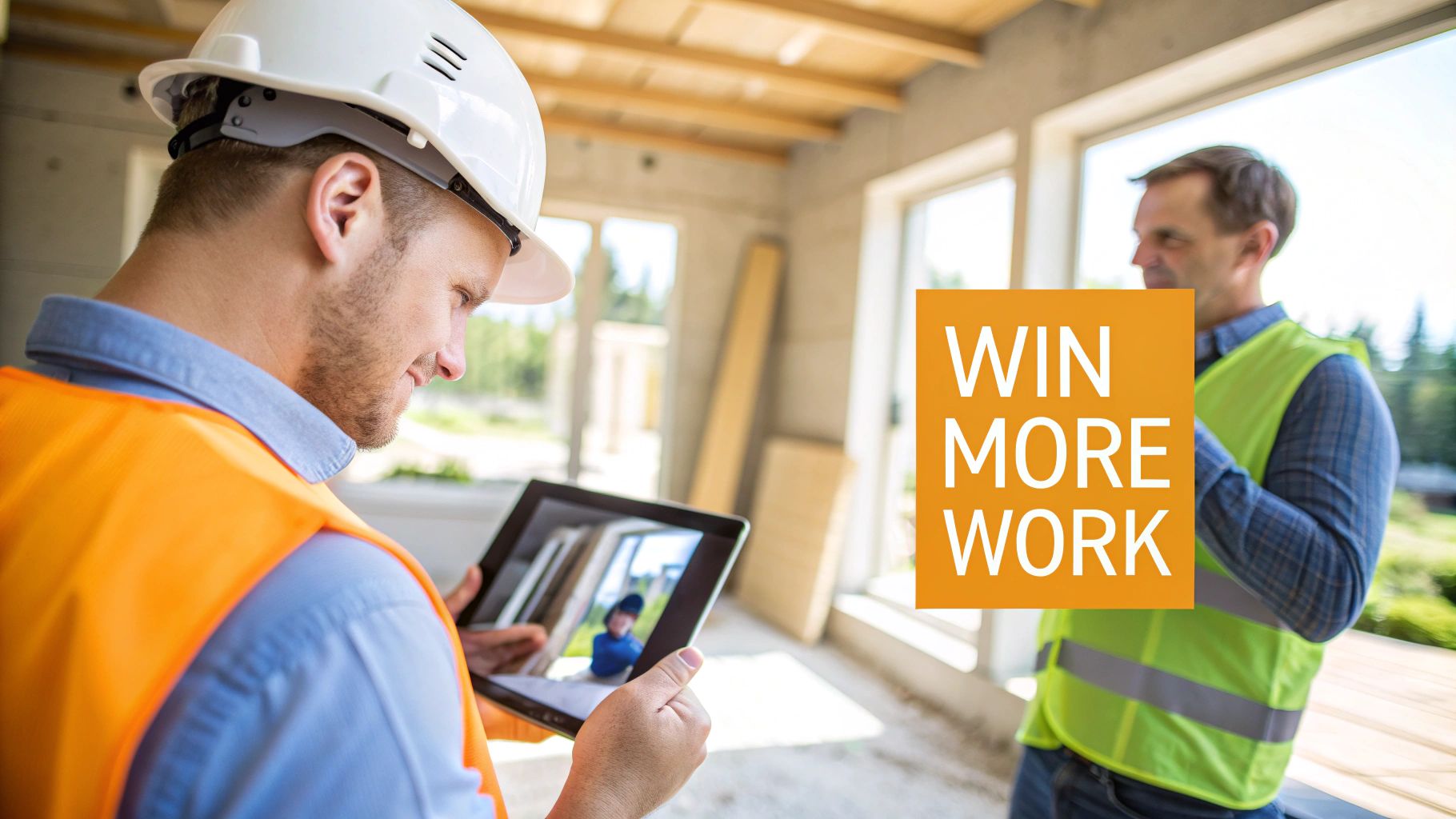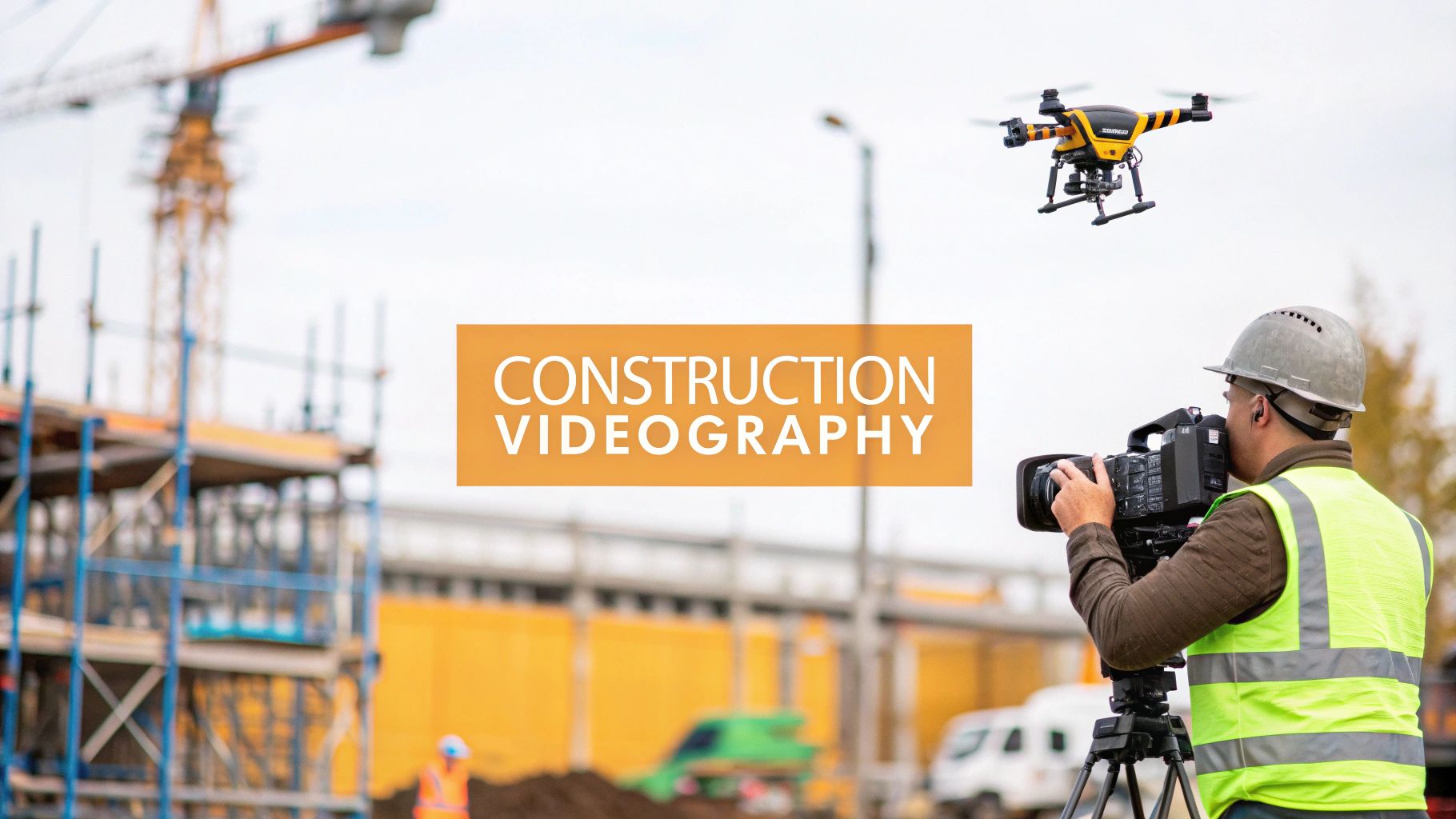


Let's get straight to it. A professionally shot video isn't a "nice-to-have" marketing piece. It's a tool that wins you more work. Construction videography tells the complete story of your build and showcases your team's skill in a way photos can't touch.

Think about explaining a complex build to a potential client. You talked them through the process, the materials, and your team's skills. Photos helped, but did they capture the scale, the movement, and the transformation? Probably not.
This is where professional construction videography changes the game.
Video doesn’t just show the finished product; it reveals the how. It builds instant trust by showing your process. A client can see the care your team takes, the precision in every cut, and the professional way you manage a project. It’s the difference between telling someone you’re a quality builder and proving it.
Photos have their place. But for capturing the heart of a construction project, video is in another league. It’s not about replacing photos, but understanding where video delivers more value for your marketing and project documents.
The takeaway is clear: video brings your work to life. It turns a static portfolio into a dynamic showcase of your capabilities.
When you're up against tough competition in a tender, a stack of photos and text can look the same. A project video makes your submission impossible to forget. It gives the client a real feel for your work, whether it’s a detailed coastal renovation or a new build in Tauranga.
A well-produced video shows potential clients exactly what they’re paying for:
A great video gives clients the confidence to choose you. It removes doubt and answers questions visually, making their decision easier.
This move to visual storytelling is gaining ground across the trades in New Zealand. The construction industry is embracing digital tools for business development, not just the build itself. Drones are now common for site monitoring, which feeds the need for high-quality video for client updates and marketing. Using video is no longer a novelty—it’s a core part of a professional operation.
Every client wants to know their project is in safe, capable hands. A video is your best handshake before you even meet. It’s an honest, practical asset that puts your pride on full display.
To see how a professional builder videographer can capture your best work, check out our guide on finding the right creative partner. It’s all about showing, not just telling, what makes your company the only choice.

You don’t need a Hollywood budget, but your smartphone won’t cut it. To capture high-quality construction videography that reflects the standard of your builds, the right gear is non-negotiable.
It’s about having reliable tools that perform in dusty, unpredictable site conditions. When you get this right, the final video looks as good as the work you do. Think of it as matching your marketing quality to your craftsmanship quality. That’s how you win trust.
The camera is the heart of your kit. On a construction site, you need something rugged and versatile. It has to handle dust and changing light while delivering a sharp image.
Your best options fall into a few categories:
Nothing looks more amateur than shaky footage. Professional video feels smooth and controlled. This is where stabilisation tools are essential. They’re the difference between a cinematic walkthrough and a dizzying home movie.
A gimbal is a handheld stabiliser that keeps the camera perfectly steady, even as you walk through a rough site. It creates that gliding look that makes a property tour feel polished and high-end. For static shots, a sturdy tripod is a must. It locks your camera down for interviews, time-lapses, or stable shots of your team, guaranteeing every frame is sharp.
Nothing shows the scale and context of a project like a drone. An aerial view can transform a building site into an impressive estate, showing how the build sits in its surroundings. This is especially powerful for large commercial jobs or a stunning residential property in Queenstown.
Drone footage is no longer a luxury; it’s a standard for high-end construction videography. It provides a "wow" factor that ground-level shots can't match, instantly elevating your project's perceived value.
When using a drone, it’s critical to work with a certified operator who understands New Zealand's Civil Aviation Authority (CAA) rules. A professional handles all safety checks and permissions, making sure those impressive shots are captured legally and safely.
Video is only half the story. The other half is audio. Terrible sound quality can ruin a great video. If you’re including interviews with the project manager or client testimonials, you need clean audio.
Your camera's built-in mic won't cut it. A dedicated lapel microphone (lav mic) is essential for interviews, clipping directly onto the speaker for crystal-clear voice recording. To capture ambient site sounds, a shotgun microphone on the camera will isolate the sounds you want while reducing unwanted noise. Good audio makes your story believable and professional.
Having the gear is one thing. Knowing how to use it on a busy construction site is another. This is where skill and planning separate average footage from a video that sells your work.
The goal isn't to just point and shoot. It’s to tell a story. Your video needs a beginning, a middle, and an end, just like the project. By using a few core filming techniques, you can create a narrative that walks a potential client through your process and builds undeniable trust.
Think of your video like a house. It needs a solid foundation. In video, that foundation is your shot list. Mixing these shots keeps a viewer engaged and helps tell the full story.
Your go-to shot list should include:
Moving between these three types of shots creates a great visual rhythm. You can show the grand scale of the site, then punch in to the fine details of the work.
If there’s one secret weapon in construction videography, it's the time-lapse. Nothing else can condense months of hard work into a few mesmerising seconds. It's the most effective way to show progress.
A well-executed time-lapse shows the entire journey, from the first concrete pour to the roof going on. It’s a powerful asset for client updates, stakeholder reports, and your marketing. It’s the ultimate proof of your ability to get the job done.
A time-lapse doesn’t just show what you built; it shows how you built it. It’s a visual testament to your process, planning, and project momentum.
Your people are your greatest asset. Featuring them in your video adds an authenticity that stock footage can't touch. Film your team working safely and professionally in clean, branded gear. It reinforces your company’s high standards.
On-site interviews are another great way to add a human touch. A short chat with the project manager can offer insight into the project's challenges and successes. Keep it natural—no scripts. Ask open-ended questions like, "What was your favourite part of this build?" Their genuine pride and expertise will shine through.
This professional content is becoming the standard. New Zealand's screen production sector saw huge growth, generating NZ$10 billion in total output between 2014 and 2021. While that’s not just construction, it proves there's a huge appetite for high-quality video.
These polished videos are perfect for sharing online. For more ideas, check out our guide on video production for social media.
Capturing great footage on-site is only half the job. The real magic happens in the edit, where hours of clips are shaped into a compelling story about your build.
Post-production is where construction videography delivers its value. By focusing on the best moments, you end up with a crisp, engaging video that highlights your team’s expertise and wins over potential clients.
The foundation of a smooth edit is organisation. A single shoot can create hundreds of files, so start by creating folders labelled by date and location, like “Kitchen Walkthrough” or “Exterior Drone Shots.”
Once it’s tidy, find the story. Watch every clip and pull only the shots that carry weight.
A great video is built on what you choose to leave out. The editor’s job is to cut away everything that doesn’t serve the story, leaving a tight, compelling final product.
Next, arrange your chosen clips on the timeline. You might start with a sweeping drone shot, move to medium angles of your crew, then zero in on close-ups of fine finishes. Keep the pace lively so every shot makes an impact without dragging.
If your project includes interviews, clear audio is vital. To speed up your workflow, you can how to transcribe video to text with AI to find the perfect soundbite in seconds.
With the edit structured, it’s time for the final touches that make your video exceptional. These steps reinforce your brand’s professionalism and ensure every frame looks its best.
The infographic below shows a simple process for capturing the core shots that form the foundation of your edit.

Varied shots are the secret to a dynamic final video.
While the broader video production market in New Zealand was valued at NZ$1.6 billion in 2025, the demand for construction videography mirrors the health of the building industry. For more on the sector’s scale, see the New Zealand Motion Picture and Video Production Market Size on IBISWorld.
A polished, professionally edited video isn’t just for looks—it’s a powerful asset that builds trust and helps you win the next big contract.
A great video is useless if the right people don't see it. The point of investing in construction videography is to get results—more leads, stronger bids, and a pipeline of quality projects.
Now that you have this asset, it’s time to put it to work. Think of your video as a multi-purpose tool that serves you at every stage of the client journey. From grabbing attention to closing the deal, your video can do the heavy lifting.
This is how you turn your investment into a return. It's about being strategic and getting your craftsmanship in front of the clients you want to work with.
Your website is your most important digital asset, and your video should be front and centre. Placing a project showcase or brand video on your homepage is the fastest way to build trust with a potential client.
Within seconds of landing on your site, they can see the quality of your work and get a feel for your process. It’s a powerful first impression that photos can't compete with. A slick video also keeps people on your site longer, which is a great signal to Google.
Beyond the homepage, your project portfolio is the perfect place for individual videos. Let clients explore your past work, like a stunning waterfront build in Westmere or a complex renovation in Remuera.
Social media helps you connect with a wider audience and build your brand's reputation. Different platforms need different content, so tailor your videos accordingly.
A consistent social media presence, powered by high-quality video, keeps your company top-of-mind. For a deeper dive, our guide on video production for social media offers practical tips for builders.
This table breaks down where to share your videos and the goal for each platform, helping you get the best return.
By matching the right video to the right platform, you're being strategic, not just posting content.
This is where your video becomes a secret weapon. When you submit a tender, you're often up against other builders who look good on paper. Including a link to a professional project video can make your submission stand out immediately.
A video in your tender doesn't just describe your capabilities—it proves them. It gives the decision-maker a virtual site tour, showing them the quality they can expect.
Instead of just telling them you finished a similar project on time, show them. A two-minute video communicates more than a ten-page document ever could, building the confidence they need to choose you.
Your video assets aren't just for winning new work. They are also valuable tools for your internal operations.
You can use your construction videos for workplace safety training, offering clear visual demonstrations of procedures. Use footage to onboard new team members, showcasing your company's standards from day one. These videos are also great for project debriefs to review what went well. It's a smart way to get maximum value from your investment.
By distributing your video content across these key channels, you ensure your investment in construction videography pays off. You'll attract better clients, win more contracts, and build a brand that reflects the quality of your work.
Investing in professional video can feel like a big step. You want to be sure every dollar counts. Here are straightforward answers to the questions builders ask us most about construction videography.
There isn’t a flat fee. The price depends on the job's scale and complexity. A half-day shoot of a renovated bach will cost less than a six-month time-lapse of a new commercial complex in Christchurch.
Think of it this way:
The cost is often a tiny fraction of a high-value contract. If the video helps you secure even one extra build, it has already paid for itself.
A professional videographer will provide a quote outlining:
Always ask for a detailed proposal. That way, there are no surprises, and you know exactly what you’ll get.
Both formats have value, but they serve different roles.
A Project Showcase Video is your polished, end-of-job highlight reel. It’s shot when the dust has settled. Its purpose is to wow prospective clients with top-notch finishes. Display this on your website to make a strong first impression.
A Progress Video is like an on-site diary. You capture regular updates—time-lapses, quick walkthroughs—to keep clients and stakeholders informed. It’s less about slick production and more about clear communication.
A few simple steps will elevate the final footage and reflect your quality standards.
Drone angles add real impact, but you can’t just fly one anywhere in New Zealand. The Civil Aviation Authority (CAA) has rules around:
A certified drone pilot will manage all consents and safety plans. Whether you’re in central Auckland or rural Otago, they’ll keep everything above board.
At Onsite Media, we specialise in high-end photography and cinematic video that helps New Zealand’s top builders win more work. Ready to turn your craftsmanship into a compelling marketing tool? Let’s talk.
Find out how we can help at Onsite Media.

